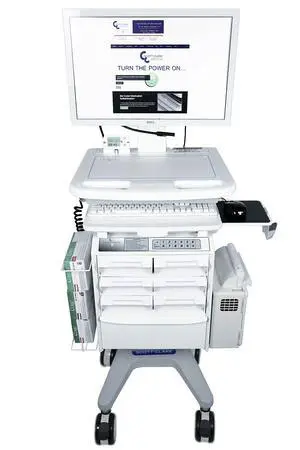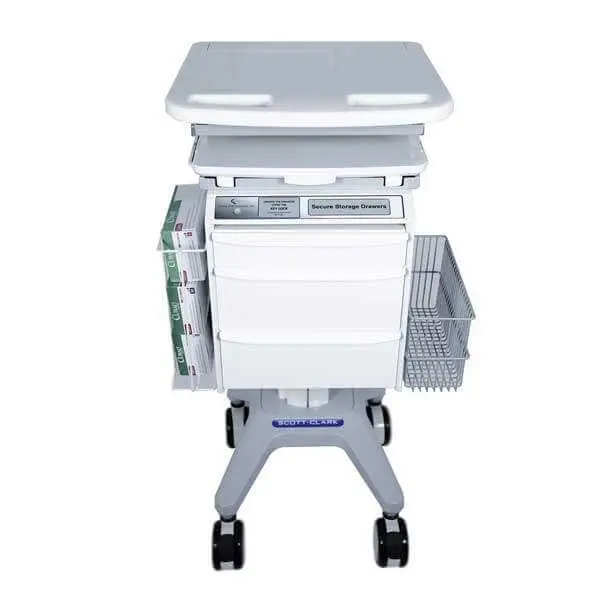|
What is in a crash cart? What’s In a Crash Cart and How Is It Used? Equipment Airway (oral and nasal) all sizes McGill forceps, large and small King Airway set (3) eliminates the need for a laryngoscope and endotracheal tubes Bag valve mask (adult and pediatric) Nasal cannula Non-rebreather oxygen face masks (3 sizes) IV start packs Normal saline solution (1000ml bags) IV tubing Angiocaths (various sizes) 10ml normal saline flush syringes (3) Gauze Alcohol preps Monitor with defibrillator (preferred) or AED Syringe nasal adaptor (nasal Narcan atomizer) A checklist confirming everything that should be on the cart Drugs Aspirin 81mg tablets Nitroglycerin spray or 0.4mg tablets Dextrose 50% (dextrose 25% if treating pediatrics) Narcan 1mg/ml (6) Epinephrine 1:10,000 Abboject™ (3) Atropine Sulfate 1mg Abboject™ (3) Amiodarone 150mg vial (4) EpiPenⓇ (2) EpiPen JrⓇ (2) Solumedrol 125mg vial Benadryl 50mg vial (2) Adenosine 6mg (4) Lopressor 10mg (2) Cardiazem 20mg vial (2) Pronestyl (procainamide) 1g in 10ml 100mg/ml vial (1)  
A crash cart, otherwise known as a code cart, is an essential piece of equipment for doctors and nurses when they need to treat life-threatening conditions such as a cardiac arrest. Hospitals can locate crash carts on wheels used in hospitals at the end of a ward where patients are most likely to need resuscitation or cardioversion. These could be cardiac wards, emergency departments, or geriatric wards. The speed with which a medic can find these carts in hospitals for transportation and dispensing of emergency medication could be the difference between life and death. Each physician may have their unique preferences as to what should be on their cart and the order in which they prefer to organize the medicines and equipment. However, there are standard items that physicians will need on every crash cart that can potentially save lives. Sides and Top of a Cart The sides and top of a cart will carry materials and devices that physicians need to access immediately. This area can include a heart monitor, defibrillator with leads and paddles, CPR board, oxygen tank, suction devices, bag valve masks, a sharps bin and IV bags, and fluids. Drawers While sometimes called trays, drawers, shelves on wheels, or medication compartments, the storage area on a crash cart is crucial. While each physician may organize their cart to their preference, they will all carry the same life-saving equipment. Drawer 1 In a cardiac emergency, the defibrillator is probably the most critical piece of equipment. After that, breathing devices are the next tools the medic may need. The top drawer is likely to contain intubating equipment, endotracheal tubes, nasal devices, 10cc syringes, and laryngeal masks. Drawer 2 Medications to help with patient distress may be next. Pharmaceuticals such as epinephrine, atropine, and sodium bicarbonate will be available. Drawer 3 When stabilizing a patient who has suffered a cardiac arrest, the physician may attach an IV fluid from the bags stored on the cart. They are likely to have a dedicated drawer for storing syringes, catheters, adhesive materials, and drip lines to ensure this process can be efficient and smooth. Drawer 4 Now that the patient is stabilizing, the physician may want to measure blood pressure, pupil dilation, and other vital signs. This drawer could contain a flashlight, blood pressure monitor, and thermometer. While this will all be on the crash cart, they will be for a quick reading of vital signs. After the physician puts these back on the wagon, nurses will use the equipment in the main hospital ward. Drawer 5 This section could contain additional fluids, spare central lines, and medications. This drawer will usually be as a back-up to the leading equipment and drugs and only used in unusual circumstances. Organization is Crucial While the crash cart is essential for treating a cardiac arrest, and the physician will use the equipment mentioned to treat their patient, the organization of the cart is equally vital. If a physician has to search for the equipment they need, it may be too late to treat their patient by the time they find it. A qualified professional will have clearly labeled each set of trays, drawers, and cabinets with a list of the devices and medications that they contain. After each use, a qualified professional must take the time to ensure they restock each drawer and that every piece of equipment is in the right place. Mobile cardiac carts on wheels used in hospitals can be of use to physicians who work different shifts. There could be severe consequences if a colleague were to use a cart, and then not replace the used items. Also, each cart should have clear instructions for each professional to follow in the event of a cardiac emergency. It may be the case that in the process of treating a heart-related condition, the physician decides they need to follow medical surgical emergency for life support protocols, in which case each member of the team needs to know what to do. Final Thoughts Cardiac crash carts can allow a physician to reach a patient quickly, having already collected a nearby cart with all the emergency medication equipment onboard. In these situations, response times are crucial, and having a mobile cardiac cart available could be the difference between a positive or negative patient outcome. |
Last Updated: May 23, 2022
